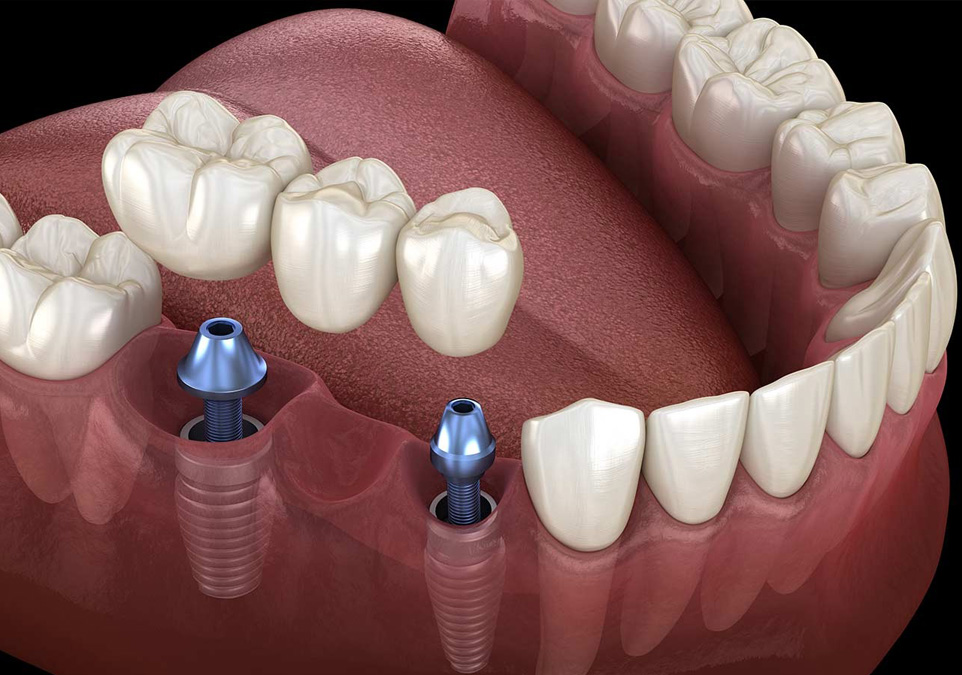Dental Bridges

What Are Dental Bridges?
Though there are several types of dental bridges, they all serve a similar purpose. Bridges use the teeth that you still have as a way to support a replacement tooth. Think of your remaining teeth as anchors, and the replacement as held between them, supporting it from either side.
Below are the four types of bridges you can receive. The type will depend on how many teeth you are missing and the placement of teeth around them.
Traditional Bridge
Cantilever Bridge
Maryland Bridge
This unique style of bridge uses porcelain or metal frameworks to hold your replacement tooth in place. They aren’t as sturdy as traditional bridges, so they require care not to strain them. Teeth that experience biting force usually aren’t suitable for replacement with this kind of bridge.
Implant-Supported Bridge
This style of bridge is excellent for patients who are missing multiple teeth. The bridge and replacement teeth are held in place by dental implants, which are sturdy metallic rods secured to your jawbone. These provide fantastic durability. The reason is that your jawbone begins to grow around the rod implants, making them extremely strong.
Dental Bridge Procedure
Since a bridge procedure is non-surgical, local anesthesia is usually enough. For patients who experience anxiety, speak with Dr. Patel about our sedation dentistry options. Our goal is that every patient has a comfortable experience at My Dentist Anaheim.
Receiving bridges usually is a multiple-step process. During your first visit, your teeth are prepared for the bridges, and impressions are taken. These impressions are used to make custom-made bridges that match your unique mouth shape and size.
While waiting for your custom bridges, you will likely receive temporary crowns. During your second visit, these crowns are removed, and the final bridge structure is placed.
The procedure can vary slightly depending on what kind of bridges you end up receiving. Some dental bridges, such as implant-supported bridges, may be a longer process since they require extra steps.
Recovery
Since no incisions are made, dental bridge recovery is quite rapid. Most of the time, patients are able to eat the same day as the bridge placement. Adapting to life with bridges is quite straightforward most of the time. Still, if you have any questions or concerns, Dr. Patel and his staff will gladly provide assistance.
Though recovery is quick, it is still essential to follow Dr. Patel’s instructions after the procedure. Dental bridges still require care if you want them to last, so a healthy oral care routine is a must.

Are Dental Bridges Right for Me?
If you are missing a tooth or multiple teeth, dental bridges can be an excellent way to restore your smile. During your appointment with Dr. Patel, he will go over all your treatment options.
Some patients will find bridges are better, while others might elect for dental implants. Bridges are great for patients who don’t have enough bone mass to support implants. Implants don’t require the neighboring teeth to be shaved down. However, for some patients, bridges are a great way to address teeth that might need crowns while replacing missing teeth at the same time.
Schedule an Appointment Today
If you have lost a tooth from decay or injury, dental bridges may be what you need to fill that tooth-shaped hole in your life. Schedule an appointment today to learn about your treatment options. Quick action can save both your tooth and your smile.
If you have any questions or concerns, the staff at My Anaheim Dentist is here to help. During your appointment with Dr. Patel, he will provide you with all the information you need about your treatment options.
